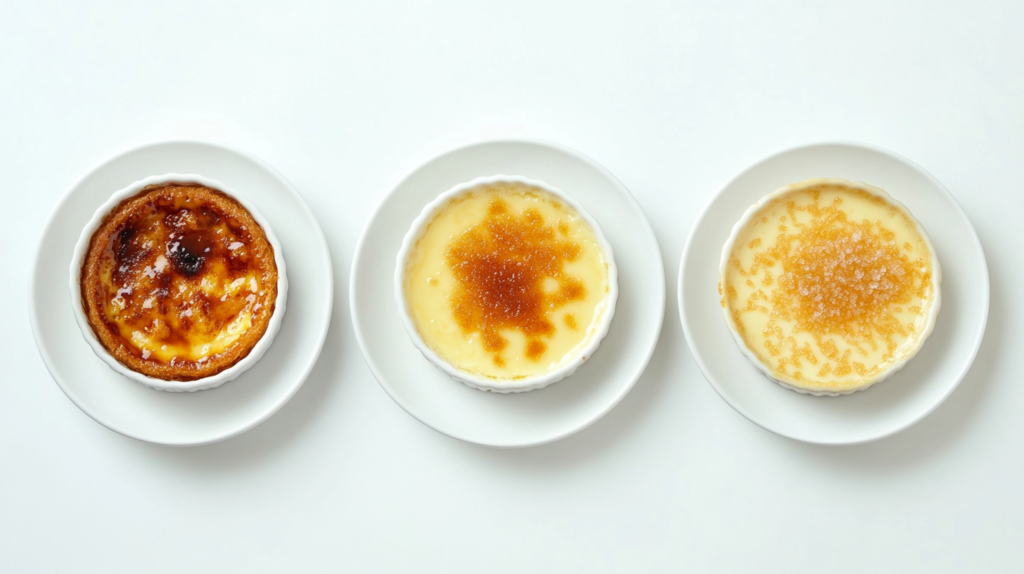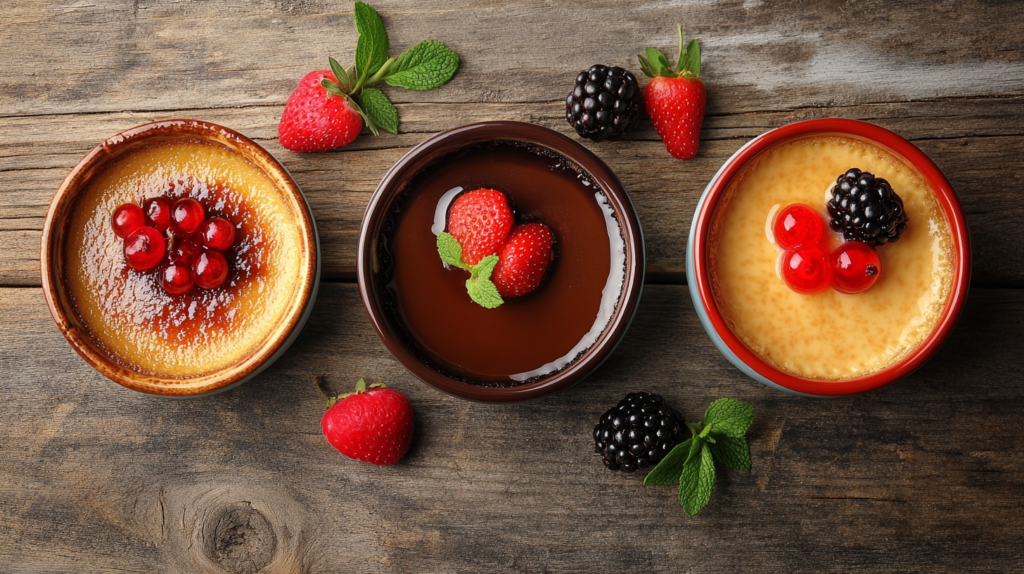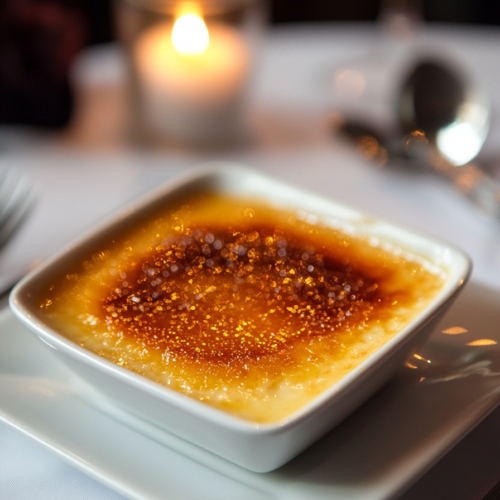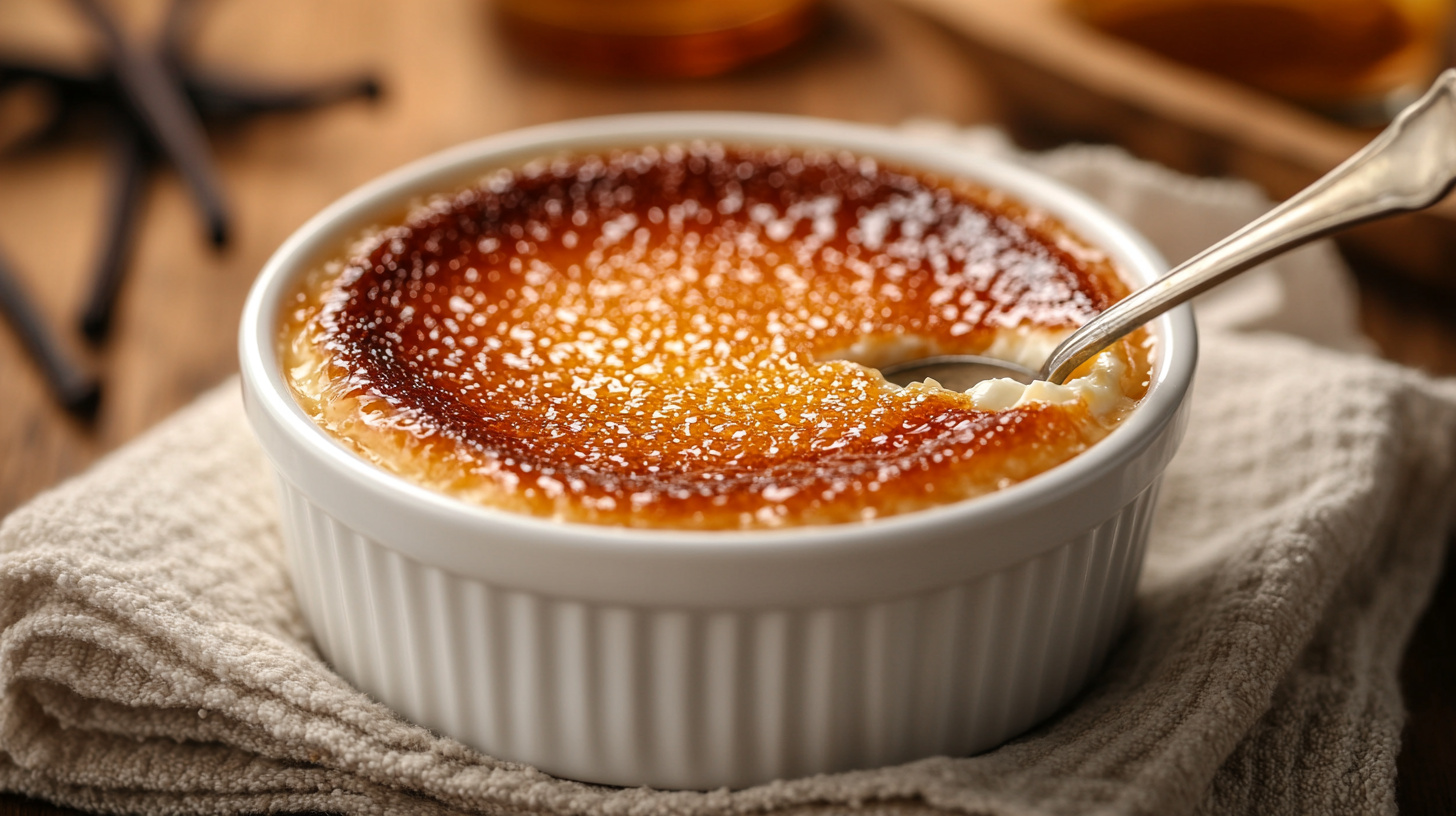Caramel Crème Brûlée is a timeless dessert that embodies elegance and indulgence. With its rich, velvety custard and perfectly crisp caramelized sugar top, this French classic has captivated dessert lovers for centuries. Whether served in a high-end restaurant or made at home, the contrast between the creamy interior and the crackling caramel crust makes every bite an experience.
In this ultimate guide, we will explore the origins of Crème Brûlée, its essential ingredients, step-by-step preparation, common mistakes to avoid, and creative variations. Whether you’re a seasoned baker or a beginner, by the end of this article, you’ll be ready to master the art of making the perfect Caramel Crème Brûlée.
Before diving in, you may also love Churro Cheesecake: The Ultimate Dessert Fusion, another caramelized dessert that pairs crispy pastry with a creamy filling.
Table of Contents
The Origins of Crème Brûlée
Caramel Crème Brûlée, which translates to “burnt cream” in French, has a history as rich as its custard base. While many associate this luxurious dessert with French cuisine, its origins are widely debated. Some culinary historians believe Caramel Crème Brûlée dates back to the 17th century, while others argue it has even older roots.
Early Beginnings
The earliest known mention of a custard dessert with a caramelized sugar crust appeared in a 1691 French cookbook by François Massialot, a chef for the French royal court. His version of Caramel Crème Brûlée was slightly different from what we know today, as the sugar topping was caramelized using a heated iron, rather than a modern kitchen torch.
However, similar desserts existed in other European countries around the same time. Spain had “Crema Catalana,” a custard with a burnt sugar top flavored with cinnamon and citrus, while England boasted “Trinity Cream,” a near-identical dish served at Trinity College, Cambridge. Despite these variations, Caramel Crème Brûlée remains the most well-known and beloved version worldwide.
The French Influence
Despite its possible multicultural origins, France popularized and perfected Caramel Crème Brûlée. By the 19th century, it had become a staple of French patisseries and fine dining establishments, cementing its reputation as a luxurious dessert.
Modern-Day Popularity
Crème Brûlée experienced a resurgence in the 1980s, thanks to French chefs bringing it into high-end restaurants across the world. Today, it remains a favorite on dessert menus and is often adapted with various flavors and ingredients, from vanilla bean to exotic fruits and liqueurs.
The Perfect Ingredients for Caramel Crème Brûlée
A flawless Caramel Crème Brûlée starts with just a few simple yet high-quality ingredients. Each component plays a crucial role in creating the dessert’s signature creamy texture and caramelized crust. Let’s break down the essentials and what makes them so important.
1. Heavy Cream – The Foundation of Creaminess
The base of Crème Brûlée relies on heavy cream, which provides its luxurious, silky texture. A higher fat content (at least 35%) is ideal because it ensures a smooth and rich custard. Using lighter dairy alternatives, such as half-and-half or whole milk, may result in a thinner, less decadent consistency.
2. Egg Yolks – The Binding Agent
Egg yolks thicken the custard, giving it structure and a luscious mouthfeel. They also add a natural golden hue to the dessert. For best results, use fresh, organic egg yolks, as they have a richer flavor and better emulsifying properties.
3. Sugar – For Sweetness and Caramelization
Granulated sugar is used in two parts of the recipe:
- In the custard: It sweetens the base without overpowering the natural richness of the cream.
- On top: A thin layer of sugar is torched or broiled to create the signature caramelized crust, which adds a crisp contrast to the creamy filling.
4. Vanilla – The Signature Flavor
Classic Crème Brûlée is infused with vanilla, which enhances its depth of flavor. The best option is real vanilla bean—its tiny black specks add an aromatic complexity that elevates the dessert. However, pure vanilla extract or vanilla bean paste can also be used as substitutes.
5. Caramel – The Indulgent Twist
Traditional Crème Brûlée has caramel only on the top, but a Caramel Crème Brûlée incorporates caramel directly into the custard. This adds a deeper, slightly nutty sweetness. The caramel is made by heating sugar until it turns golden brown and then carefully mixing it into the cream before combining it with the eggs.
Choosing the Best Ingredients for a Superior Crème Brûlée
| Ingredient | Best Choice | Why It Matters? |
|---|---|---|
| Heavy Cream | 35-40% fat cream | Creates a rich and smooth custard |
| Egg Yolks | Organic, fresh | Provides structure and a creamy texture |
| Sugar | White granulated sugar | Ensures even caramelization |
| Vanilla | Vanilla bean or pure extract | Enhances aroma and depth of flavor |
| Caramel | Homemade caramelized sugar | Adds a deep, nutty sweetness |
How to Make Caramel Crème Brûlée at Home

Making Caramel Crème Brûlée at home may seem intimidating, but with the right technique, anyone can achieve restaurant-quality results. This step-by-step guide will walk you through the process, from preparing the custard to achieving the perfect caramelized top.
Step 1: Preparing the Caramel and Custard Base
Ingredients:
- 2 cups heavy cream (35% fat)
- 5 large egg yolks
- ½ cup granulated sugar (plus extra for caramelizing)
- 1 vanilla bean (or 1½ tsp pure vanilla extract)
- ¼ cup sugar (for caramel)
- A pinch of salt
Instructions:
- Make the caramel:
- In a saucepan over medium heat, melt ¼ cup of sugar until it turns golden brown.
- Once fully caramelized, slowly add ½ cup of heavy cream, stirring constantly to prevent clumps.
- Remove from heat and let it cool slightly.
- Infuse the cream:
- In another saucepan, heat the remaining 1½ cups of heavy cream over medium heat.
- If using a vanilla bean, split it lengthwise, scrape out the seeds, and add both the seeds and pod to the cream.
- Bring to a gentle simmer (do not boil), then remove from heat and let the flavors infuse for 10 minutes.
- Whisk the egg yolks and sugar:
- In a mixing bowl, whisk 5 egg yolks with ½ cup sugar until the mixture is pale and slightly thickened.
- Slowly add the warm caramel-infused cream while whisking continuously to prevent the eggs from scrambling.
- Strain the mixture through a fine sieve to remove any lumps or foam.
Step 2: Baking the Custard
- Preheat the oven to 325°F (160°C).
- Prepare a bain-marie (water bath):
- Place ramekins in a deep baking dish.
- Pour the custard evenly into the ramekins.
- Fill the baking dish with hot water (not boiling), ensuring it reaches halfway up the ramekins.
- Bake for 30-40 minutes, or until the custard is set but still slightly wobbly in the center.
- Cool and refrigerate:
- Remove the ramekins from the water bath and let them cool to room temperature.
- Cover and refrigerate for at least 4 hours (or overnight for the best texture).
Step 3: Achieving the Perfect Caramelized Top
- Sprinkle sugar:
- Just before serving, evenly sprinkle 1-2 teaspoons of granulated sugar over each custard.
- Caramelize the sugar:
- Using a kitchen torch: Move the flame in circular motions until the sugar melts and turns golden brown.
- Using the broiler method: Preheat the oven to high broil and place the ramekins under the broiler for 1-2 minutes until caramelized.
- Let the caramel harden for 1-2 minutes before serving.
Expert Tips for Success
- Use fresh, high-fat cream for a smooth, rich texture.
- Temper the eggs by adding warm cream slowly to prevent curdling.
- Avoid overbaking—the center should have a slight jiggle.
- Torch the sugar just before serving to keep the caramel crisp.
Common Mistakes and How to Avoid Them
Even though Caramel Crème Brûlée seems simple, a few small mistakes can ruin its texture and flavor. Here are the most common pitfalls and expert tips on how to avoid them.
1. Overcooking the Custard
Problem: The custard becomes rubbery or develops a scrambled egg texture.
Solution:
– Bake at low temperatures (325°F/160°C) to prevent curdling.
– The custard is done when the edges are set, but the center still has a slight jiggle.
– Remove from the oven before it fully sets, as it will continue to firm up while cooling.
2. Skipping the Bain-Marie (Water Bath)
Problem: The custard bakes unevenly, leading to a cracked or curdled texture.
Solution:
– Always bake in a water bath to regulate temperature.
– Use hot (not boiling) water to ensure gentle, even cooking.
– Make sure the water reaches at least halfway up the ramekins for even heat distribution.
3. Not Tempering the Eggs Properly
Problem: Adding hot cream too quickly to the eggs results in scrambled bits.
Solution:
– Temper the eggs by slowly whisking in warm cream, adding it gradually to prevent cooking the yolks.
– Strain the mixture through a fine sieve before pouring into ramekins to catch any lumps.
4. Uneven or Burnt Caramel Top
Problem: The caramelized sugar is too thick, burns too quickly, or remains grainy.
Solution:
– Use superfine sugar for better melting and even caramelization.
– Sprinkle a thin, even layer of sugar on top—too much will create a thick, hard crust.
– If using a torch, move it in small circles instead of holding it in one place.
– If using a broiler, watch closely to avoid burning.
5. Serving Crème Brûlée Too Soon
Problem: The custard is too soft or hasn’t fully set.
Solution:
– Refrigerate for at least 4 hours, or ideally overnight, for the best texture.
– Torch the sugar right before serving to keep the top crisp.
6. Storing It Incorrectly
Problem: The custard absorbs fridge odors or the caramel softens over time.
Solution:
– Cover the ramekins with plastic wrap to prevent odor absorption.
– Do not caramelize the sugar until just before serving, as it will soften if stored in the fridge.
By avoiding these mistakes, you can achieve a smooth, creamy custard with a perfectly crisp caramel top every time!
Creative Variations of Caramel Crème Brûlée

While the classic Caramel Crème Brûlée is already a masterpiece, there are plenty of exciting ways to customize and enhance this dessert. By incorporating different flavors, ingredients, and textures, you can create a unique twist that suits your taste.
1. Chocolate Caramel Crème Brûlée
For chocolate lovers, this version adds deep cocoa richness to the classic recipe.
How to Make It:
– Melt 2 ounces of dark chocolate into the warm caramel-infused cream before combining with the egg mixture.
– Use a bittersweet chocolate (70% or higher) for a richer, more intense flavor.
– Top with cocoa-dusted caramelized sugar for a gourmet finish.
2. Coffee Caramel Crème Brûlée
A perfect dessert for coffee enthusiasts, combining espresso’s boldness with caramel’s sweetness.
How to Make It:
– Add 1 tablespoon of espresso powder or brewed espresso to the cream while heating.
– A sprinkle of coffee-flavored sugar on top adds extra depth.
– Pair with a dark chocolate garnish for a café-style experience.
3. Salted Caramel Crème Brûlée
Adding a touch of sea salt enhances the caramel flavor, creating a sophisticated balance of sweet and savory.
How to Make It:
– Stir ½ teaspoon of sea salt into the caramel before mixing with the cream.
– Use flaky sea salt (like Maldon) for a gourmet touch on top after caramelizing.
– Pair with a salted caramel drizzle for extra indulgence.
4. Fruit-Infused Caramel Crème Brûlée
Adding fruit brings freshness and a delightful contrast to the rich custard.
Popular Variations:
– Berry Crème Brûlée: Layer fresh raspberries or strawberries at the bottom before pouring the custard.
– Citrus Crème Brûlée: Add orange zest or lemon zest for a bright, tangy flavor.
– Tropical Crème Brûlée: Use coconut milk instead of heavy cream and add a hint of mango puree.
5. Boozy Crème Brûlée
Infusing alcohol adds complexity and depth to the dessert.
How to Make It:
– Add 1 tablespoon of liqueur to the warm cream before mixing with eggs.
– Best options:
- Baileys or Kahlúa for a creamy coffee twist.
- Grand Marnier for an orange-infused flavor.
- Rum or Bourbon for a warm, smoky finish.
6. Dairy-Free & Keto Crème Brûlée
A healthier alternative without sacrificing texture or flavor.
Dairy-Free Version:
– Replace heavy cream with full-fat coconut milk or almond milk.
– Use coconut sugar for a natural sweetener.
Keto-Friendly Version:
– Use heavy cream and egg yolks as usual, but swap sugar for erythritol or monk fruit sweetener.
– Caramelize the top with a sugar-free sweetener that melts well.
Serving Suggestions
For a refreshing twist, serve your crème brûlée with fresh berries or alongside a scoop of Strawberry Cheesecake Ice Cream for a delicious contrast of textures.
Looking for more classic French desserts? You might enjoy French Apple Pie: A Delicious Twist on a Classic Dessert.
Pairing Suggestions
Crème brûlée pairs wonderfully with espresso or a creamy liqueur. For an indulgent coffee pairing, check out Tiramisu Coffee: The Perfect Blend of Espresso and Dessert.
For those who prefer no-bake options, you might also love No-Bake Cherry Cheesecake: Easy & Creamy Recipe.
Final Thoughts on Flavor Variations
- Experiment with spices: Cinnamon, nutmeg, or cardamom can add warmth and complexity.
- Try exotic extracts: Almond, lavender, or rosewater can create delicate floral notes.
- Mix textures: Serve with crushed nuts, cookie crumbles, or chocolate shavings for extra crunch.
Frequently Asked Questions (FAQs)
Why is my Crème Brûlée grainy instead of smooth?
A grainy texture usually results from overcooking or baking at too high a temperature. To prevent this:
– Bake at 325°F (160°C) and check for a slight jiggle in the center.
– Use a bain-marie (water bath) to ensure even cooking.
– Temper the eggs by adding warm cream gradually to prevent curdling.
Can I make Crème Brûlée without a torch?
Yes! You can caramelize the sugar using the oven broiler:
– Set the oven to high broil.
– Place the ramekins 2-3 inches below the heat.
– Watch closely and rotate if needed to prevent burning.
How long does Crème Brûlée last in the fridge?
Uncaramelized Crème Brûlée can be stored for 3-4 days in the refrigerator, covered with plastic wrap.
Once caramelized, it’s best served immediately, as the crisp sugar top softens over time.
Can I freeze Crème Brûlée?
Yes, but only the custard base—not the caramelized top.
– Freeze for up to 1 month in an airtight container.
– Thaw in the fridge overnight and caramelize before serving.
What’s the best sugar to use for the caramelized topping?
Superfine sugar works best because it melts evenly.
Brown sugar can be used for a deeper, molasses-like flavor, but it may burn faster.
Can I make Crème Brûlée in advance?
Yes! You can prepare the custard 1-2 days ahead, refrigerate it, and caramelize the sugar just before serving for the best texture.
What is the difference between Crème Caramel and Crème Brûlée?
The key difference between Crème Caramel and Caramel Crème Brûlée lies in their preparation and texture:
– Crème Caramel is a custard dessert with a soft caramel sauce on top. It is baked in a water bath and then inverted onto a plate, allowing the caramel to create a syrupy topping.
– Caramel Crème Brûlée, on the other hand, has a hard, caramelized sugar crust on top. The sugar layer is torched or broiled until crisp, creating a delightful contrast between the creamy custard and the crunchy top.
What is the secret of Crème Brûlée?
The secret to a perfect Caramel Crème Brûlée lies in three key factors:
– Gentle baking: Use a low oven temperature (325°F/160°C) and a water bath (bain-marie) to prevent curdling.
– Tempering the eggs: Gradually add warm cream to egg yolks to avoid scrambling them.
– Even caramelization: Use superfine sugar and a torch or broiler to achieve a crisp, golden caramel topping.
How to caramelize Crème Brûlée without a blowtorch?
If you don’t have a kitchen torch, you can still caramelize Caramel Crème Brûlée using a broiler:
– Step 1: Sprinkle an even layer of granulated sugar over the custard.
– Step 2: Preheat your oven’s broiler to high.
– Step 3: Place the ramekins on a baking sheet and position them 2-3 inches below the broiler.
– Step 4: Watch closely and broil for 1-2 minutes, rotating if needed, until the sugar melts and turns golden brown.
– Step 5: Let it cool for a minute before serving to allow the caramel to harden.
What is the difference between egg custard and Crème Brûlée?
Egg Custard is a general term for baked or stirred custards made with eggs, milk, sugar, and flavoring. It is often softer and can be served hot or cold.
– Caramel Crème Brûlée is a richer, creamier version that uses heavy cream instead of milk and has a signature caramelized sugar topping, adding texture and flavor contrast.
Conclusion
Caramel Crème Brûlée is a timeless dessert that combines luxury and simplicity in every spoonful. With its silky custard and crisp caramelized top, it’s a true masterpiece that can be made at home with just a few key techniques.
By understanding its origins, perfecting the technique, and experimenting with flavors, you can create a Crème Brûlée that rivals the finest French restaurants. Whether you stick to the classic vanilla-caramel version or explore creative chocolate, coffee, or fruity variations, this dessert is sure to impress.
Now that you’ve mastered the art of Caramel Crème Brûlée, why not give it a try? Grab your ramekins, fire up your kitchen torch, and enjoy the satisfying crack of caramelized sugar as you dig in!
Want more indulgent treats? Browse our collection of delicious dessert recipes for more inspiration!

Caramel Crème Brûlée
Equipment
- Saucepan
- Mixing Bowl
- Whisk
- Ramekins
- Fine-Mesh Sieve
- Baking Dish
- Kitchen Torch
Ingredients
For the Caramel Layer
- 1/4 cup water
- 1/2 cup granulated sugar
For the Custard
- 2 cups heavy cream
- 1 teaspoon vanilla extract or 1 vanilla bean
- 1/4 teaspoon salt
- 4 large egg yolks
- 2 tablespoons granulated sugar
For the Caramelized Topping
- 2 teaspoons granulated sugar per ramekin
Instructions
- In a saucepan, heat 1/4 cup water and 1/2 cup sugar over medium heat without stirring until it turns a deep amber color. Quickly divide the caramel among the ramekins, swirling to coat the bottom evenly.
- In another saucepan, heat 2 cups of heavy cream over medium heat until it begins to simmer. Remove from heat and stir in vanilla extract and salt. Let it sit for a few minutes to infuse.
- In a mixing bowl, whisk together 4 large egg yolks and 2 tablespoons of sugar until pale and slightly thickened.
- Slowly pour the warm cream into the egg yolk mixture, whisking constantly to prevent curdling.
- Pour the mixture through a fine-mesh sieve into a clean bowl to remove any lumps, ensuring a smooth custard.
- Evenly divide the custard among the caramel-lined ramekins.
- Place the ramekins in a deep baking dish and fill it with hot water until it reaches halfway up the ramekins. Bake at 325°F (160°C) for 40-45 minutes, or until the custard is set but slightly wobbly in the center.
- Remove ramekins from the water bath and cool to room temperature. Cover and refrigerate for at least 2 hours (or overnight for the best texture).
- Before serving, sprinkle 2 teaspoons of granulated sugar evenly over each custard. Use a kitchen torch to melt the sugar until it forms a golden, crisp crust. If you don’t have a torch, place the ramekins under a broiler for 1-2 minutes, watching carefully to prevent burning.

